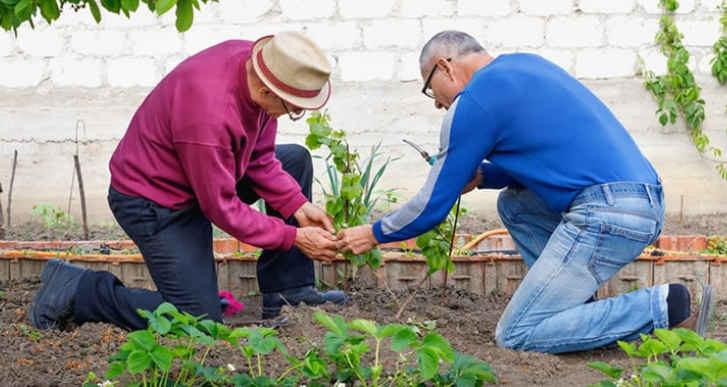Andrew Gallagher
Gardening is a rewarding and therapeutic activity enjoyed by many individuals. However, the physical nature of gardening can sometimes lead to back injuries if proper precautions are not undertaken. Whether you are planting flowers weeding, or harvesting vegetables, it is essential to be mindful of body mechanics and practices that can protect your back. In this article I will be discuss effective strategies to prevent to back injuries while working in your garden, ensuring you can enjoy he pleasure of gardening for years to come.
Before delving into prevention strategies, it is essential to understand the common types of back injuries that can occur while gardening. Among these are:
Muscle strains: Probably the most common,often caused by over exertion, incorrect lifting , or simply fatigue. Muscle strains can cause sharp pain which often settles into a dull ache that may limit your mobility.
Herniated Discs: A more severe issue that occurs when the soft tissue material between the vertebrae bulges or ruptures.
his often results from improper lifting and can cause significant discomfort and mobility issues.
Sciatica: Nerve pain which caused by compression resulting from repetitive motions or poor posture while gardening. Symptoms may includes pain, numbness or tingling that radiates down the leg.
The Importance of warming up and stretching.
Just like any physical activity, its crucial to warm up before you start gardening. Warming up increases blood flow to your muscles, making them more flexible, reducing the risk of strain.
Simple warm up exercises include:
- Neck Rolls: Gently roll your neck in circles to loosen tension.
- Shoulder shrugs. Lift your shoulders towards your ears hold for a moment and then release them.
- Torso Twists. Stand with your feet shoulder width apart and gently twist your torso from side to side.
- Following your warm gently stretch your leg and back muscles by simple stretches such as toe touches back bends and lunging to enhance flexibility and prepare your body for the tasks ahead.
Choosing the right tools
Ergonomic Tools: Invest in ergonomic tools with padded grips and longer handles to reduce the need to bend over. Tools such as ergonomic shovels hoes and pruners are designed to minimise back strain. As a general rule hand tools with thicker handles reduce the strain on wrists elbows and shoulders reduce the mechanical stress of repetitive movements that lead to injuries such as tendonitis.
The ready availability of light weight and battery powered garden tools including single handed pruning chainsaws and loppers reduce the physical effort involved in the more heavyduty aspects of garden maintainence. It is important to remember to keep your tools sharpened and the moving parts well lubricated to enhance their efficiency which in turn reduces the effort required in their use.
When having to move heavy objects around the garden such as garden pots or cart bags of potting mix it is important to make use of wheelbarrows garden carts and hand trolleys to avoid the risk of lifting injuries.
Posture is important
Posture plays an important role in preventing back injuries. Maintaining an aligned spine while gardening can help minimise stress on your back. Here are some useful tips to keep your posture in check:
- Bend Your Knees: when lifting or planting, always bend your knees rather than the waist. This action engages your legs strength instead of putting pressure on your back.
- Keep Objects Close: When lifting keep objects close to your body. This practise helps maintain balance and reduces he strain on your lower back, minimising the risk of injury.
- Rotate Your Body: Instead of twisting your torso move your feet and rotate your whole body. This technique prevents excessive strain on your spine and facilitates safe coordinated movement.
- Take Regular Breaks: Gardening can be physically demanding. Schedule regular breaks to relieve stress on your back and recharge your energy.
- Change Positions regularly: Vary your tasks and positions regularly during gardening to avoid overworking any specific muscle group. Periodically switching between standing kneeling and sitting can help distribute the workload evenly.
Utilize Supportive Practises
Incorporating supportive practises into your gardening routine can significantly reduce the risk injury.
- Kneeling Pads: Use kneeling pads or cushions when planting or weeding to reduce pressure on your knees and lower back. Look for pads that provide adequate support without being too bulky.
- Standing Mats: Place cushioned standing mats on hard surfaces to decrease strain while standing. These mats help reduce the impact on your joins and provide comfort during long of periods of standing.
- Sit While You Work: Consider the use of al ow stool or seat while working close to the ground. This practise can help prevent bending and strain on your back, allowing you to maintain comfort and proper alignment while gardening.
Pay Attention to the Surface
The type of terrain in your garden can affect your back’s health. Here are some suggestions for managing your gardening environment effectively:
- Clear Obstacles Ensure that your gardening area is free of obstacles and tools that could cause you to trip and fall. Keeping the space organised can prevent accidents that lead to injury.
- Cultivate Level Ground: If possible, create planting and working areas that are level to reduce the chance of straining your back while navigating uneven surfaces. In the vegie garden consider creating raised garden beds to minimize stooping when working or harvesting produce.
Listen to your Body
It is important to listen to your body when engaging in any physical activity gardening included. If you start to feel pain or discomfort, it is essential to stop and assess what you are doing
- Always remember to keep well hydrated whilst working in the garden particularly in the warmer months of the year.
- Recognise signs of pain: It is normal to be fatigued after along day of gardening but sharp or persistent pain can be assign of injury. Be proactive identifying these signals.
- Modify your activities: If you feel discomfort in your back, consider switching to lighter tasks or take a break. Adjusting your gardening technique can also help for instance, if weeding causes pain,try kneeling instead of bending over, or switch to a standing weeding tool.
- If you have a history of back issues or are unsure about your body’s limits, consider consulting a healthcare professional for personalized advice and exercises to enhance your strength and flexibility tailored to your specific circumstances.
Gardening can be a fulfilling hobby that that brings pleasure to your life. However back injuries can dampen your experience if you are not careful. By adopting smart practises, using the right tools, and listening to your body, you can protect your back and continue to enjoy the pleasures of gardening.
The essence of gardening lies in savouring the moment, the beauty, and fruits of your labor. Remember, prevention is always easier than the recovery. Prioritizing your health will ensure your health will ensure that your gardening remains a joy for many years to come.
Happy Gardening!
Andrew Gallagher Physiotherapist Springs Medical ( Enthusiastic Gardener).





